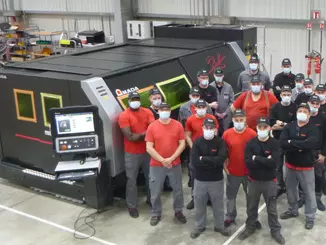
Laser cutting technology is now more than established. The areas of application have been steadily expanded, the laser power is constantly increasing and the cutting quality of fiber lasers is now even sufficient for use in medical applications, at least at Amada.
Small parts in particular tend to tip or fall through the support grid. Both are hugely disadvantageous, as tilting parts can lead to collisions with the cutting head and parts that fall through the support grid are exposed to flying sparks and hot slag.
Amada has thought about both directions. On the one hand, the software can be used to influence where the parts are positioned on the support grid in order to make tipping less likely; on the other hand, if a part does tip over and the head collides with the part, various protective mechanisms take effect.
In the event of a collision, the cutting head deflects. This is possible because it is spring-mounted, which prevents mechanical damage as far as possible. The head is then retracted, centers itself using the so-called “Auto Head Recovery” function and can then automatically get ready for cutting again using the “i-nozzle checker”. The nozzle is checked using a high-resolution camera and, if necessary, automatically replaced, centered and calibrated, after which the machine can continue cutting immediately.
Of course, an even more intelligent solution is one that prevents such collisions or parts falling through from the outset.
In the past, these were so-called “micro corners”, a material composite in material thickness that held the part in the panel. The disadvantages are obvious. On the one hand, it is more time-consuming to remove such a line and on the other hand, reworking is always necessary. In the next instance, Amada developed the “Nano Joint” many years ago; this is now used almost everywhere. The nanojoint reduces the material composite to around 20 to 30 percent of the material thickness. This has the advantage that less force is required to remove the part and that reworking can be significantly reduced.
Amada has now presented its latest development, the so-called “Soft Joint”, at the Blechexpo in Stuttgart. This patented process utilizes the thermal influence during cutting within defined limits. Before the part is cut free, a number of slots are laser-cut and placed at strategic stops. When the free cut is made, the resulting tabs bend against the component and fix it in the panel.
The advantage: The parts hold securely in the sheet metal, can be removed with minimal effort and, last but not least, no reworking is required.
The arrangement of the retaining tabs requires no additional programming and is suitable for any geometry, including round parts.
Web:
www.amada.de



